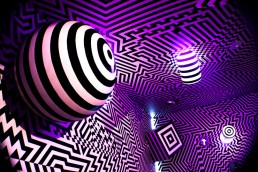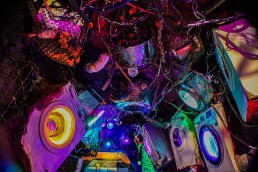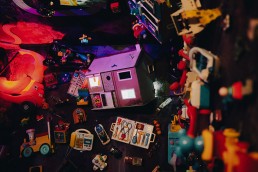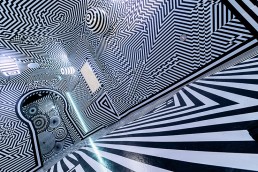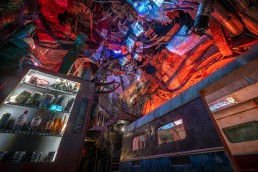This website uses cookies so that we can provide you with the best user experience possible. Cookie information is stored in your browser and performs functions such as recognising you when you return to our website and helping our team to understand which sections of the website you find most interesting and useful.
Wake The Tiger
ProjectWake The TigerLocationBristol, UKArchitectGraham MacVoyLighting DesignerLuke MitchellInstallerWake The TigerAcousticianGreg ChapterSubmitted byPlaster Creative Communications
Wake The Tiger (WTT) is the world’s first Amazement Park®, designed and created by the team behind Boomtown Festival and creatives working on attractions worldwide. Its second phase was completed in January 2024. The ‘OUTERverse’ saw the creation of 15 new environments, bringing the total to over 40 immersive rooms with integrated soundscapes and interactive audience experiences.
WTT’s comprehensive audio system runs on Ableton, creating a multi-channel connected and synchronised soundscape across the many speakers placed throughout the experience. This is enabled by Dante, which provides a virtual soundcard that sends all audio over an IP network, which allows the team to have a central control system for every room within the attraction. This enables the system to be mixed live in the space.
Crucially, the system also collects live information from a variety of sources to trigger sound effects based on guest movements and interactions within the exhibits.
The system was concepted and commissioned by audio specialist Greg Chapter, who composed much of the score alongside guest sound designers for specific spaces as well as creating generative sound throughout the attraction. The audio was initially composed in a studio setting, before Greg completed the final mixes in the room in which the audio plays in the experience. This meant that speakers could be hidden, prioritising user immersion over traditional acoustic speaker placement. Each room features a mix of LEA CONNECT 88D, 8-channel 100 W amplifiers, and Genelec PoE-enabled speakers. The audio throughout the space was designed with motion in mind, placing synthesisers throughout the rooms, which play arpeggiated sequences triggered by movement in the room.
There are some stand out audio experiences. The Crystal Chamber, a crystalline-inspired experience, features audio run off one LEA CONNECT 88D and an 8-channel 100 W amplifier, which enables channels to be addressed individually. Four channels created the effect of surround panning, with ExBox triggers feeding into Resolume, creating OSC messages to trigger content as you move through the room. This creates an ambient soundtrack that grows in intensity when the room is busy and softens when fewer people are there.
The lighting for WTT is led by Technical Manager Louis Norwood and light artist Jack Wimperis.
As a team, WTT has harnessed the power of addressable LEDs throughout the rooms, wirelessly controlled by ESP32s and a WLED program, which facilitates the manipulation of colour palettes, visual patterns, playlists and dynamic effects. Each is seamlessly integrated into a network that is accessible via a mobile app so each can be altered remotely. This system also connects sensors across the building, which trigger effects in response to movement in some of the rooms.
The Crystal Chamber was crafted by AV technicians and projection map experts Ed Metcalf and Megan Broadmeadow from D-Unit Studios, featuring software made by in-house software programmer, Alex Waite. The ceiling features LED mesh, incorporating over 16,400 controllable LEDs and 40,000 LEDs with generative control, concealed behind a handcrafted ceiling made from recycled panels that come together to create a room that replicates a crystal. These are mapped through a protocol called Artnet, which responds to people moving around the room through Xbox 360 Kinect v1 cameras. This creates different light sequences, Touch Designer visuals and immersive soundscapes, unveiling a zoetrope effect that becomes the central pinnacle of the room.
WTT created water and oil effects using light projectors and custom gobos in the Sanctuary. An ADJ H20 light projector and custom gobo were used to imitate the movement of water and light, while the oil effect was achieved by pairing two Solo 250 projectors with an oil wheel projector and custom oil wheels, which were handmade by artists in Bristol.
The use of LEDs extends throughout the experience, with the iconic Mycelium Room featuring a ceiling which interlaces 2,500 LEDs with fibre optics sealed within resin.
The D.O.D.E.C. room’s dodecahedron houses an infinity-mirror effect that is augmented by vibrant LEDs that are orchestrated through Resolume. The LEDs move at an incredibly high rate of 100 frames per second, and all are controlled through a video processor linked to both Resolume and the floor projections, offering a fully immersive light experience.
The WTT experience is a visual playground, encouraging visitors to engage and explore within the park.
In the new ‘OUTERverse’, 15 Optoma projectors were chosen due to their vivid brightness and resolution, and deployed to cater to the diverse nature of each installation. The projectors are mapped using Resolume by Nathaniel Archer of Aether Projects, which converge to display visuals that are seamlessly synchronised with audio cues and LED installations.
TouchDesigner is also an integral part of WTT’s visual network, with the ability to control software that allows for intricate and interactive visual experiences. The software’s adaptability enables the integration of Kinect cameras and the opportunity for other input sources, allowing flexibility across immersive environments. Through this platform, the team have created an intuitive touch screen in the Aetheria room, granting users the ability to manipulate projections that are cast across a 15 ft walk through head.
The recent expansion also features part of a recycled aeroplane. In this ‘Astral Plane’, guests have access to Oculus 2 VR headsets that are suspended from the ceiling of the Airplane cabin. They are invited to take part in a tailor-made virtual experience crafted by The Cyberdelic Society. Despite the unconventional use of consumer-grade VR technology, the 3D-printed fixings allow for accessibility for all visitors.
Another visual marvel of WTT takes place in The Void. Visitors are invited to transcend consciousness and walk through an interactive projection room that is orchestrated by Touch Designer and Kinect Azure depth cameras. The depth cameras were connected to one of four Optoma ZH350ST 3500 with Lumen DLP Laser 1080 technology projectors to give the effect of the body transcending into particles.
In the Dazzle room, creators OTTER Producers enlisted designers TAPT, to design psychedelic patterns that were converged with Unity and Unreal Engine to craft surreal optical illusions. The interactive black and white lines create dizzying installations and the touch-sensitive pads encourage exploration with light that changes with different movements and touches within the room.
WTT embraces projection mapping and non-contact engagements that propel visitors into an otherworldly experience that captivates and encourages playfulness.
WTT wanted to offer gold-standard accessibility throughout the venue to allow every visitor to enjoy the same immersive experience. This commitment was extended to Aetheria, the biggest room in the OUTERverse. The room consists of a 15ft sculpture that has a life-like face projected onto it with two Optoma ZH462 projectors. Video technician, Nathaniel Archer, meticulously mapped visual effects on a massive scale that two control panels control – orchestrated by DMX to enable a brilliant experience whether viewed from floor level or an upper balcony.
WTT prides itself on resourcefulness and innovation, utilising recycled materials and found objects, even in its technological implementation. As a start up, the team had world class ambitions but a budget a fraction of the size of similar attractions, meaning that creating software enabled solutions was critical to creating the effects desired by the artists. WTT shifted their focus on their system design and component selection to ensure the durability of thousands of visitors engaging with the experience, without losing its bespoke quirkiness.
WTT also aimed to have interactive spaces in use while preventing queues. For example The Void is a small passageway that symbolises transformation and transcendence. The challenge lay in designing an interactive space that evoked emotion and could be used by multiple participants simultaneously, ensuring no waiting time due to the walk-through nature of the immersion. This was achieved through back projection using four Optoma ZH350ST projectors that were set against a black rear projection screen. This created an environment where visitors’ movements were simultaneously tracked and translated into vibrant colours and light trails causing little delays in the immersive walk-through experience.
Throughout the planning and construction phases, sustainability remained at the forefront of all of WTT’s considerations. From the offset, it was clear achieving their ambitious creative vision while maintaining minimal environmental impact would create challenges. The team drove creative solutions resulting in the careful consideration of the AV equipment’s energy efficiency and compatibility with the venue’s sustainability goals.
WTT, the world’s first Amazement Park, is a year-round immersive art experience, which features a multi-layered labyrinth of over 40 unique art spaces that expand visitors’ imaginations and challenge perceptions. Blurring the lines between an interactive experience, art gallery and film set, it offers an adventure for all ages.
WTT is a frontrunner in innovation, particularly in harnessing cutting-edge technology to turn simple effects into something that inspires visitors. Each space is individual in design, but connected through a state of the art dashboard, which controls every piece of equipment and sensor in the building.
The first phase was so well received with 300,000 visitors in the first 18 months, that the second phase was immediately put into planning, with more complex technology solutions. The team’s and collaborative art’s own development has been led by the WTT project, trying new things and working with artists to make the seemingly impossible, possible. This has driven innovation, which has then gone on to be used in major building projects across the world.
The team prides itself on repurposing old technology to reduce waste and encourage sustainability, and through true innovation creates new experiences. Embracing DIY solutions, such as 3D-printing of commercial VR headsets, and placing 16,000 LEDs behind recycled panels, the experience’s unparalleled use of new and old technology amplifies its mission to encourage visitors to leave thinking about their impact on the world.
As a beacon of creativity in the UK, WTT called out for independent creatives to leave their mark on the one-of-a-kind attraction. The experience has organically developed, bringing together artists, technologists, inventors and creatives. With this inclusive approach, the experience gained a sense of ownership and pride that injected agency, depth and richness throughout the expansion.
